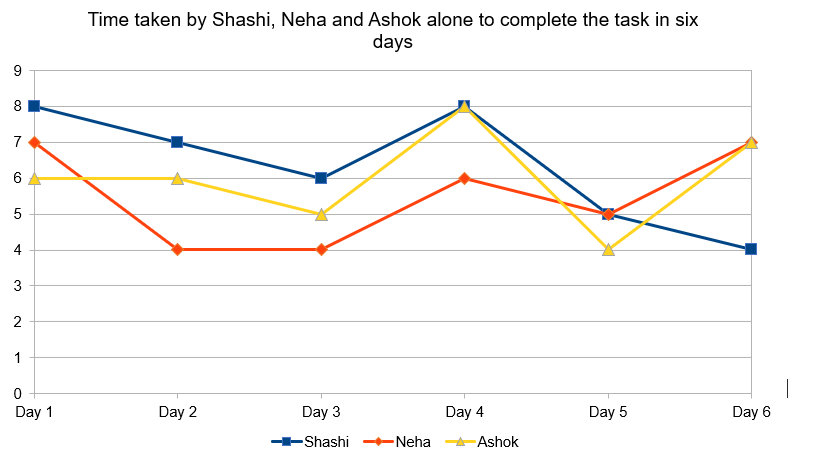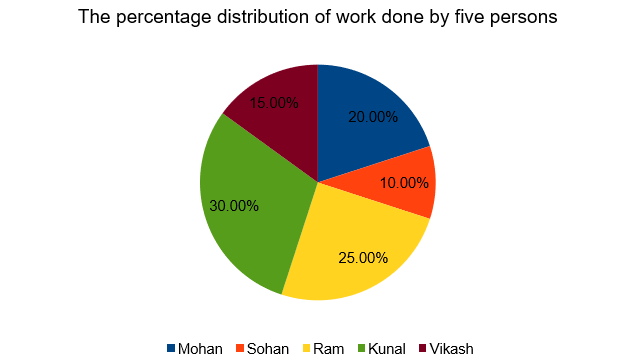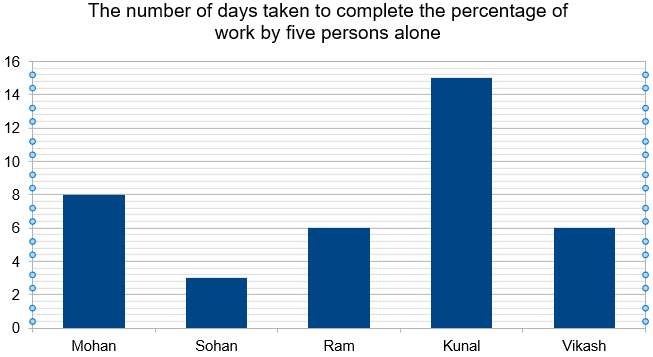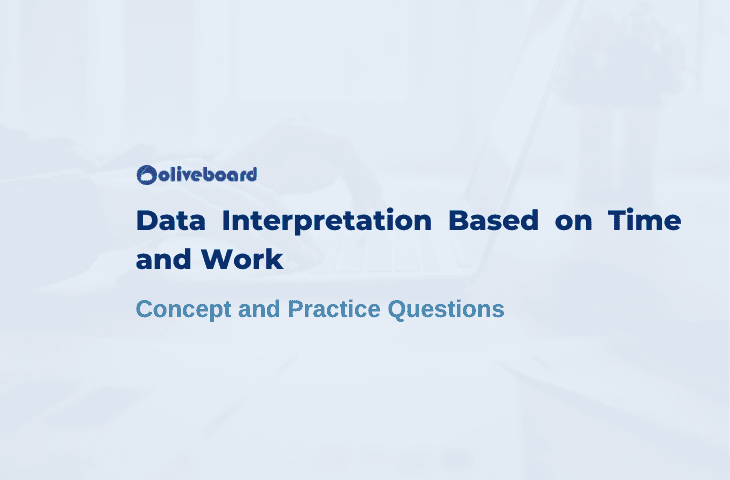In this article, we will talk about Data Interpretation based on Time and Work. In Data Interpretation, a large volume of data is organized and is represented into a compact and precise form which is easier to interpret than the raw data. Students are required to draw conclusions and inferences from comprehensive data presented numerically. The data is given in the form of graphs (pie chart, bar graph, line graph, etc), tables, or in the form of caselets.
Register Here to Take Oliveboard’s Free Mock Test
1. Introduction to Data Interpretation Based on Time and Work
Data Interpretation based on Time and work is a type of representation in which values of variables are represented in proportion with efficiency or number of days taken by men or women to complete the work or part of work done. This topic is very important as in the recent examinations we have seen this kind of DI being asked very frequently.
For more understanding, you can also watch the video on Data Interpretation based on Time and Work. In this video, he discussed questions that are based on Time and Work. To watch this video please click here.
Register on Oliveboard & Get Bank, SSC & RRB NTPC Free Mock Tests
2. Practice Questions for Data Interpretation Based on Time and Work
Let us understand Data Interpretation based on Work and Time with the following two examples:
SET 1: 5 Questions
The following data shows the working hours for three employees (Shashi, Neha, and Ashok) in six days to complete a task. The working hours also indicates the time taken by them to complete the same task alone.

Q1. What is the difference between the average of working hours of Shashi on Day 1 and Day 6 together and the average of working hours of Neha on Day 5 and Day 6 together?
(1) 4.5
(2) 2
(3) 4
(4) 3
(5) 0
Answer key: 5
Solution:
Average of working hours of Shashi on Day 1 and Day 6 together = (8 + 4)/2 = 6 hours
Average of working hours of Neha on Day 5 and Day 6 together = (5 + 7)/2 = 6 hours
Required difference = 6 – 6 = 0
Q2. On Day 2, If Shashi takes half the working hour time to complete a work while Neha takes equal time as Shashi, and Ashok takes 50% more time to complete the same work alone. What will be the ratio of their working efficiency to complete a work?
(1) 12: 18: 7
(2) 18: 18: 7
(3) 9: 9: 7
(4) 12: 12: 7
(5) None of these
Answer key: 2
Solution:
Shashi takes =7/2 hours
Neha takes = Shashi = 7/2 hours
And Ashok takes = 150/100 * 6 = 9 hours
So, ratio of their efficiency = 2/7: 2/7: 1/9 = 18: 18: 7
Q3. Working hours on Day 5 by Shashi, Neha, and Ashok are the time taken by them to complete a work alone. How much time will they take to complete thrice the same work working together?
(1) 4(8/13) hours
(2) 3(9/13) hours
(3) 4(7/13) hours
(4) 7(7/13) hours
(5) None of these
Answer key: 1
Solution:
Time taken by them to complete thrice of the work = 3 * 1/(1/5 + 1/5 + ¼) = 4(8/13) hours
Q4. On Day 4, Shashi was supposed to complete the task on time. Due to health issues, he stopped when only one-third of the task was completed. Half of the remaining work was completed by Neha alone and the rest by Ashok alone. What is the total time taken by them to complete the task?
(1) 7 hours
(2) 7(1/3) hours
(3) 6(1/2) hours
(4) 8 hours
(5) None of these
Answer key: 2
Solution:
On Day 4:
One-third of the work done by Shashi = 8/3 hours
One-third of the work done by Neha = 6/3 = 2 hours
And rest one-third of the work done by Ashok = 8/3 hours
So, total time = 8/3 + 2 + 8/3 = 7(1/3) hours
Q5. What is the ratio of total working hours of Shashi and Ashok together throughout the period of six days to that of Neha’s throughout the period of six days?
(1) 71: 33
(2) 77: 34
(3) 74: 33
(4) 75: 32
(5) None of these
Answer key: 3
Solution:
The total working hour of Shashi and Ashok together throughout the six days = 8 + 6 + 7 + 6 + 6 + 5 + 8 + 8 + 5 + 4 + 4 + 7 = 74 hours
And total working hour of Neha throughout the six days = 7 + 4 + 4 + 6 + 5 + 7 = 33 hours
So, required ratio = 74: 33
Be exam ready with our Math Coach Feature – Try it for Free Here
SET 2: 5 Questions
Study the data given below carefully and answer the following questions:
The Pie Chart given below shows the percentage distribution of work done by five persons (Mohan, Sohan, Ram, Kunal, Vikash):

The Bar graph given below shows the number of days taken to complete the percentage of work (which is mentioned in the above pie chart) by these five persons alone:

Q6. What is the ratio of efficiency of Ram and Vikash?
(1) 4: 5
(2) 5: 3
(3) 4: 3
(4) 5: 4
(5) None of these
Answer key: 2
Solution:
So, required ratio = 1/24: 1/40 = 5: 3
Q7. If Garima is 20% more efficient than Sohan, then Mohan and Garima together can complete the whole work in how many days?
(1) 1000/29 days
(2) 1000/31 days
(3) 100/31 days
(4) 100/29 days
(5) None of these
Answer key: 1
Solution:
Garima alone can complete the whole work in = 300 * 100/120 = 250 days
So, Mohan and Garima together can complete the whole work in = 1/(1/250 + 1/40) = 1000/29 days
Q8. What is the difference between the time taken by Sohan and Vikash together to complete the whole work to the time taken by Kunal and Mohan to complete the whole work?
(1) 2000/149 days
(2) 2000/151 days
(3) 2000/153 days
(4) 2000/157 days
(5) None of these
Answer key: 3
Solution:
The time taken by Sohan and Vikash together to complete the whole work = 1/(1/300 + 1/40) = 600/17 days
And time taken by Kunal and Mohan to complete the whole work = 1/(1/50 + 1/40) = 200/9 days
So, required difference = 600/17 – 200/9 = 2000/153 days
Q9. If Parul takes 10 days less than Kunal and Annu takes 6 days more than Ram to complete the whole work, then in how many days, Parul, Annu and Mohan together can complete the whole work?
(1) 10 days
(2) 12 days
(3) 16 days
(4) 15 days
(5) None of these
Answer key: 2
Solution:
Parul alone can complete the whole work in = 50 – 10 = 40 days
Annu alone can complete the whole work in = 24 + 6 = 30 days
Required days = 1/(1/40 + 1/30 + 1/40) = 12 days
Q10. If Ashok takes 20 days more than Mohan and Pratima is 20% less efficient than Vikash, then time taken by Ashok to complete the whole work is what percentage of the time taken by Pratima to complete the whole work?
(1) 100%
(2) 120%
(3) 110%
(4) 140%
(5) 90%
Answer key: 2
Solution:
Ashok alone can complete the whole work in = 20 + 40 = 60 days
Pratima alone can complete the whole work in = 100/80 * 40 = 50 days
So, required % = 60/50 * 100 = 120%
Common Solution:
20% of the work done by Mohan in = 8 days
So, Whole work done by Mohan in = 100/20 * 8 = 40 days
10% of the work done by Sohan in = 3 days
So, whole work done by Sohan in = 30 * 100/10 = 300 days
25% of the work done by Ram in = 6 days
So, whole work done by Ram in = 100/25 * 6 = 24 days
30% of the work done by Kunal in = 15 days
So, whole work done by Kunal in = 100/30 * 15 = 50 days
And 15% of the work done by Vikash in = 6 days
So, Whole work done by Vikash in = 100/15 * 6 = 40 days
That is all from us in this article. We wish you all the best for your journey throughout! You will surely make it!
Always choose the best for your preparation- Choose Oliveboard!

Hello, I’m Aditi, the creative mind behind the words at Oliveboard. As a content writer specializing in state-level exams, my mission is to unravel the complexities of exam information, ensuring aspiring candidates find clarity and confidence. Having walked the path of an aspirant myself, I bring a unique perspective to my work, crafting accessible content on Exam Notifications, Admit Cards, and Results.
At Oliveboard, I play a crucial role in empowering candidates throughout their exam journey. My dedication lies in making the seemingly daunting process not only understandable but also rewarding. Join me as I break down barriers in exam preparation, providing timely insights and valuable resources. Let’s navigate the path to success together, one well-informed step at a time.

Mam/sir ,DIs mains level imp topics upload kijiye .